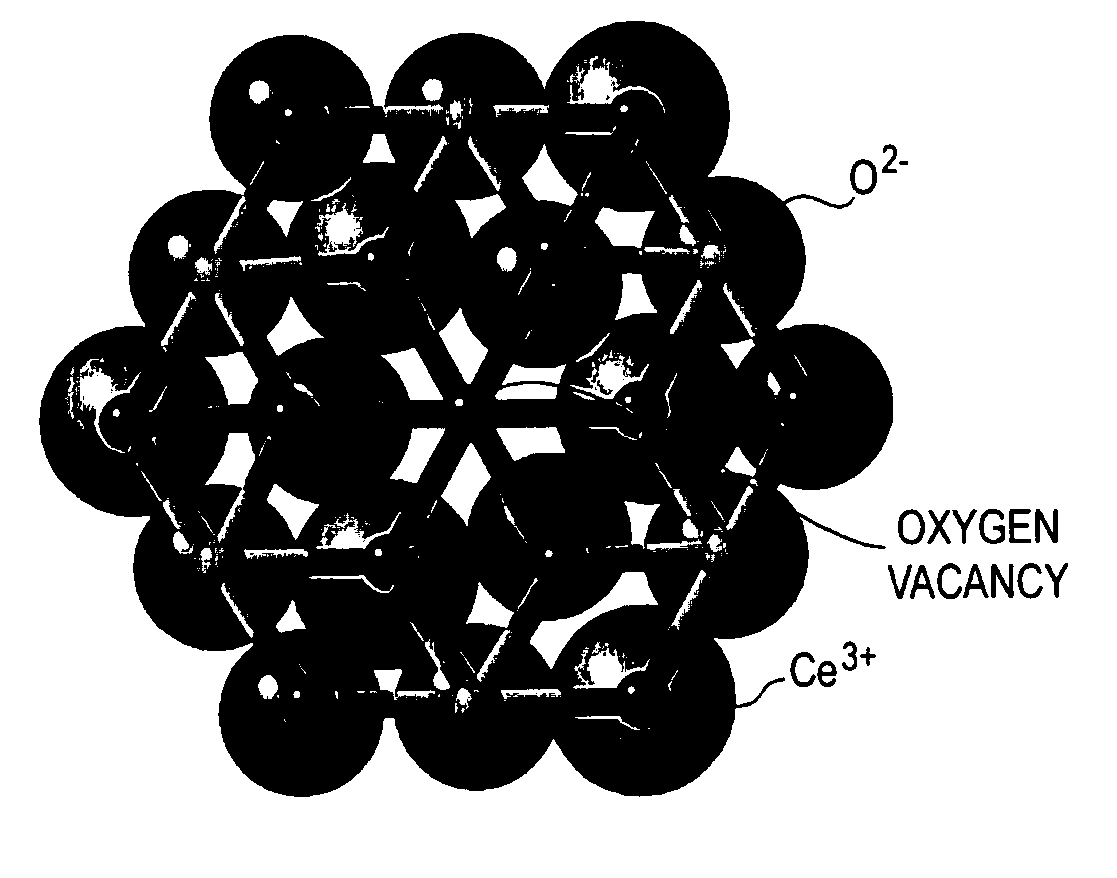Catalysts Including Metal Oxide For Organic Fuel Cells
a fuel cell and catalyst technology, applied in the direction of fuel cells, metal/metal-oxide/metal-hydroxide catalysts, coatings, etc., can solve the problems of increasing cell size, cost, start-up time, and fuel cell exhaustion,
- Summary
- Abstract
- Description
- Claims
- Application Information
AI Technical Summary
Benefits of technology
Problems solved by technology
Method used
Image
Examples
example 1
Pt / ZrO2
[0055] 0.29 g hexachloroplatinic acid hexahydrate (H2PtCl6.6H2O, available from Alfa Aesar), 1.00 g zirconia (available from Sigma-Aldrich) and 0.4 g of protective colloid stabilizer (previously dissolved in 3 g of deionized water under mixing) are dissolved in 180 ml of 1,2-propylene glycol under a nitrogen blanket. The mixture is stirred for 2 hours and is subsequently brought to a refluxing temperature of 185° C. and maintained for 3 hours. The resulting suspension of metal clusters in 1,2-propylene glycol is cooled to room temperature and allowed to age for 1 hour. After 1 hour the pH of the solution is adjusted to 1 using dilute (1.5M) hydrochloric acid. The solution is heated to 60° C. and held at this temperature for 16 hours to hydrolyze the protective shell. The resultant Pt / ZrO2 solid product is recovered by washing in water and acetone and drying in air.
example 2
Pd / CeO2
[0056] 0.24 g palladium nitrate Pd(NO3)2 (available from High Purity Standards), 1.00 g ceria (available from Sigma-Aldrich) and 0.4 g of protective colloid stabilizer (previously dissolved in 3 g of deionized water under mixing) are dissolved in 180 ml of 1,2-propylene glycol under a nitrogen blanket. The mixture is stirred for 2 hours and is subsequently brought to a refluxing temperature of 180° C. and maintained for 3 hours. The resulting suspension of metal clusters in 1,2-propylene glycol is cooled to room temperature. After 1 hour of aging, the pH of the solution is adjusted to 1 using dilute (1.5M) hydrochloric acid. The solution is heated to 60° C. and held at this temperature for 16 hours to hydrolyze the protective shell. The resultant Pt / CeO2 solid product is recovered by washing in water and acetone and drying in air.
example 3
Pd / Pt (1:1 Atomic Ratio) / SbO2—SnO2
[0057] 0.12 g palladium nitrate Pd(NO3)2 (available from High Purity Standards), 0.16 g hexachloroplatinic acid hexahydrate H2PtCl6.6H2O (available from Alfa Aesar), 1.00 g SbO2:SnO2 (available from Alfa Aesar) and 0.4 g of protective colloid stabilizer (previously dissolved in 3 g of deionized water under mixing) are dissolved in 180 ml of 1,2-propylene glycol under a nitrogen blanket. The mixture is stirred for 2 hours and is subsequently brought to a refluxing temperature of 185° C. and maintained for 3 hours. The resulting suspension of metal clusters in 1,2-propylene glycol is cooled to room temperature and allowed to age for 1 hour. After 1 hour the pH of the solution is adjusted to 1 using dilute (1.5M) hydrochloric acid. The solution is heated to 60° C. and held at this temperature for 16 hours to hydrolyze the protective shell. The resultant Pd—Pt (1:1 atomic ratio) / SbO2—SnO2 solid product is recovered by washing in water and acetone and d...
PUM
| Property | Measurement | Unit |
|---|---|---|
| Temperature | aaaaa | aaaaa |
| Electrical conductivity | aaaaa | aaaaa |
Abstract
Description
Claims
Application Information
 Login to View More
Login to View More - R&D
- Intellectual Property
- Life Sciences
- Materials
- Tech Scout
- Unparalleled Data Quality
- Higher Quality Content
- 60% Fewer Hallucinations
Browse by: Latest US Patents, China's latest patents, Technical Efficacy Thesaurus, Application Domain, Technology Topic, Popular Technical Reports.
© 2025 PatSnap. All rights reserved.Legal|Privacy policy|Modern Slavery Act Transparency Statement|Sitemap|About US| Contact US: help@patsnap.com



